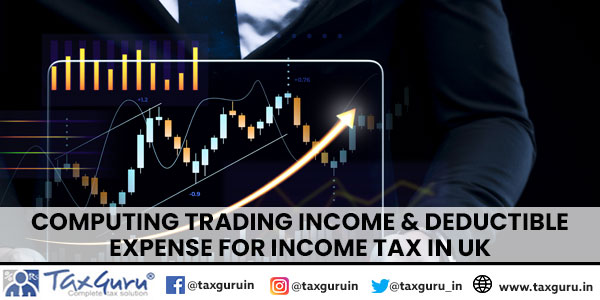Introduction: In the intricate landscape of UK income tax, computing trading income and deductible expenses is a nuanced process governed by statutory provisions, case laws, and accounting standards. The Income Tax (Trading and Other Income) Act 2005 (ITTOIA) and the principles of Generally Accepted Accounting Practice (GAAP) play pivotal roles in determining what constitutes taxable profits and allowable deductions. This discussion delves into the mechanisms of calculating trading profits, the impact of accounting guidelines, and the specific expenses that are considered deductible or non-deductible under UK tax law. We also examine the influence of capital allowances, the principle of ‘wholly and exclusively’ for business expenses, and the challenges posed by transfer pricing and connected persons in achieving tax fairness and policy objectives.
Income is taxed on profits of Trade, P or V (S5 ITTOIA). Tax is charged on the full amount of the profits arising in a tax year (S7 ITTOIA). A person is liable only on the income tax arising from trading income who ‘receives or is entitled to’ trading profits (S8 ITTOIA).
S25(1) of the ITTOIA states that the profits arising from a trade (involves what is deductible) must be calculated with respect to GAAP accountable to any necessary adjustment or authorized by the law. Statutory provisions and case laws regarding tax will make adjustments, which in turn would result in a distinct accounting and tax base.
Usually, the decision of the first-tier tribunal’s decision on accounting treatment is set in stone and quite arduous to challenge it (Ball UK Holdings Ltd).
This may be an indication that the degree of dependence on accounting guidelines to describe the tax base may produce distortions.

The accounting profession is directly correlated to the UK GAAP (S997 ITA) and IAS (1127 CTA 2010) and they aim to demonstrate a ‘true and fair’ outlook with respect to commercial companies and UK stakeholders (accounting prudence). This means any predicted expenses should be booked and deducted for accounting for possible spending of the sum, an appropriate example would be a bad debt reservation rent (Herbert), the anticipated fuel cost (Johnson), Although it might be tending to preserve the status quo for the tax base, hence deductions would only be applicable if the predicted expense is adequately fixed.
Expenses such as business entertainment, tax penalties and crime-related payments are deductible under the accounting principles, However, under tax law, we apply the legislation S45 ITTOIA and S54-55 CAA and find them not deductible as expenses following some exceptions.
The parliament invests a lot of time to make these provisions and they do have some ground reasoning behind it. Taking business entertainment, there might be a possibility to benefit the trade or the company from the entertainment itself (e.g., in the form of advertising) but it would only be granted if the business is the sole benefiting from it as being partially benefited would not be admissible under the courts as the government would want to make sure the revenue missing is at the very least wholly incurred for the purpose of the business. Similarly, any crime-related payment or tax-penalty cannot be deductible under the tax base as a penalty is a fine issued by the government to deter the crime-related activity and a deduction on such fine would defeat the purpose (McKnight v Sheppard). Timing related payments regarding employee benefit contributions (S38-44 ITTOIA) and unpaid remunerations (S36-37 ITTOIA) are not deductible till the moment the actual payment is made, this is quite contradictory to the accrual accounting and matching principle. If the payments are made under nine months, then they are deductible in the tax year but if there is no payment then there are no deductions available until the payment is made and considered as taxable under the hands of the employee. This is done as a matter of rationality and to avoid any mismatches because the payment should only have tax consequences after it turns to a taxable receipt in the hands of the employee.
Tax law is fact-sensitive, and it aims for a specific policy like Stamp duty land tax regime provides an incentive to buy land at a specific location so profits and deductions should be sufficiently different to show incentive.
Commercial depreciation is another alteration arising from the accounting principles. It may be a capital allowance to make up for a P&M asset. The limited capital expenditure leads to a low headline corporate tax rate and any change in it is a decision that regards policy and governance. Capital expenditure may be allowable for particular assets at a declining balance, the asset may straightline balance so the asset can be said to front-load all of the deduction.
The tax rate regarding profits and chargeable gains is different, hence capital expenditure is not deductible from the trading profits (S33 ITTOIA). Capital expenditures cannot be mixed with trade profits to reduce asset. The ‘wholly and exclusively’ [S34(1) ITTOIA] is followed and one may have more than one purpose. S34(2) allows a deduction for dual-purpose expense as long as an ‘identifiable part or proportion’ is incurred wholly and exclusively for the the trading purpose.
It is worth mentioning that the business managements have a top-level integration surrounding the connected persons which enable the person to have the ability to manipulate transactions in a way that leads to the lowest possible taxation. This is the main and ongoing concern of transfer pricing, DTT and CFC Rules.
With respect to deduction, we may apply the arm’s length amount and follow relevant transfer pricing guidelines.
This is done to artificially exploit the tax base and as such justifiable (as long as it is within arm’s length). It is possible to find the disparity between the modern practice and GAAP, similarly, these are legitimized by the opposing views in the policy chosen and the type of tax or accounting base that a government may want. The US tax base follows the ‘substance over form’ basis and although the UK system may not follow it advocates the need for adjustments when a policy lacks it. The legislation and judges have not expressly stated a need to define the tax base, it may be more likely attributed to the accounting practices to circumvent the legislation and exploit the tax base, frustrating the aim of the collection of the profits.
Conclusion: The calculation of trading income and deductible expenses under UK income tax law is a complex interplay between accounting standards and tax legislation. The reliance on GAAP for determining the tax base, coupled with statutory adjustments authorized by law, ensures that taxable profits are calculated in a manner that reflects both the economic reality and policy intentions. However, the differentiation between accounting and tax treatment, especially regarding capital expenditures and dual-purpose expenses, underscores the need for careful consideration to align business practices with tax obligations. Additionally, the regulatory framework addressing transfer pricing and connected persons transactions emphasizes the importance of maintaining arm’s length principles to prevent tax base erosion. Ultimately, navigating the nuances of UK tax law requires a comprehensive understanding of both the accounting and legal principles that underpin the computation of trading income and deductible expenses.





